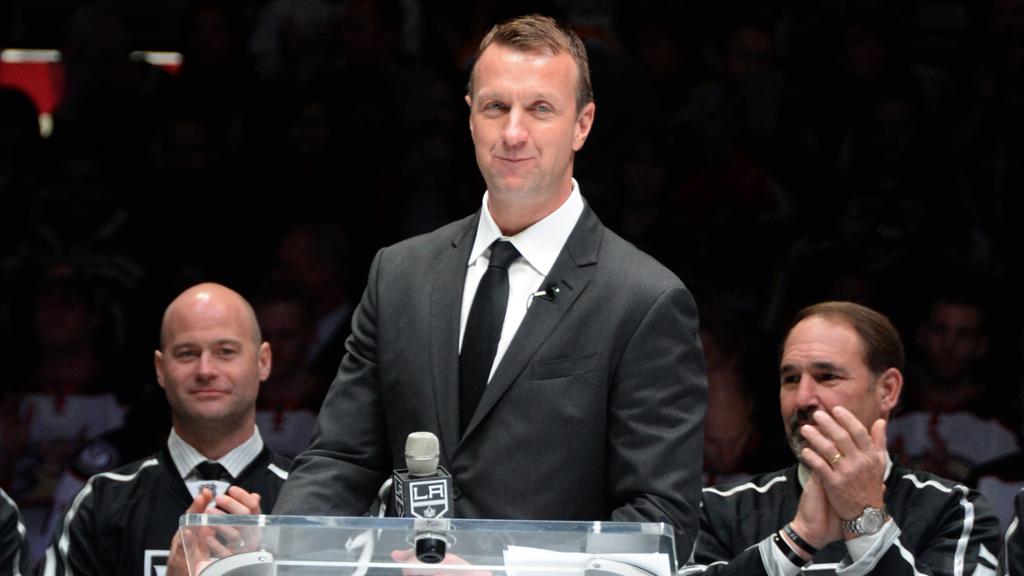July 8, 2019 | 9:35AM ET
BY Dennis Bernstein, The Fourth Period
DO GOOD THINGS COME TO THOSE WHO WAIT?
LOS ANGELES, CA – It’s been a month since we last checked in on the Los Angeles Kings’ progression along the road back to respectability. A positive development occurred as the franchise attempts to distance itself from its worst season in a decade, specifically a draft class whose depth and potential, if realized, could be the best in franchise history. The consolation prize for a 71-point season provided the luxury of drafting three times in the top 33 selections and the profile of the players they selected has reinforced the mindset change and further separation from the ways of the Dean Lombardi regime.
Alex Turcotte was a no-brainer at No.5, the best on the board when their group strode to the podium at Rogers Arena in Vancouver. While their second first-round pick continued the trend of selecting and trading for young blueline talent with Tobias Bjornfot, it’s pick 33 that had me say, “Finally, this organization took a risk.’
Whether Arthur Kaliyev ultimately fills the net in the NHL is not the point, it’s the fact that a player who possesses first-round talent but has questions about his work ethic was selected by Los Angeles.
For almost a decade, a prospect needed to have the buzz words “good soldier” or “quality character” attached to them to get on the Kings draft board. While General Manager Rob Blake’s first two drafts have been more talented-laden than his former boss, it’s this one selection that signals to me the potential of legitimately entertaining hockey at Staples Center. The possibility of a skill-laden future Los Angeles forward depth chart is a positive development for fans patiently waiting for a turn towards winning and even possibly, fun hockey.
But Kings fans are going to have to wait... perhaps longer than they like.
Los Angeles had a weak July 1 and while they will tell you it’s part of The Plan, the prospect that they have not moved a core player off this roster as the league heads towards summer leaves their transition vehicle in first gear.
There have been small moves, not qualifying fan favorite Brendan Leipsic, allowing Jonny Brodzinski to walk to Group 6 Free Agency and the necessary buyout of Dion Phaneuf (the last two TFP first reported), but a bold move similar to the signing of Ilya Kovalchuk a year ago has not materialized.
Maybe Blake feels burned from the results of the Kovalchuk free agency move, but the same names that have been rumored since last season’s trade deadline still remain – Jeff Carter, Jonathan Quick and to a lesser extent Tyler Toffoli (but the absence of contract extension talk entering his walk year speaks volumes). While the expectation is all three will be at training camp, I’ve learned there were two trades discussed around the time of the Draft in Vancouver that would have significantly impacted the roster:
An American holiday doesn't prevent us from having inside stuff for you....
— Dennis Bernstein (@DennisTFP) July 4, 2019
LA have recently kicked tires on Edmonton RW Jesse Puljujarvi.
But apparently cost of doing business is taking on Milan Lucic contract, something LA not inclined to do at this time
Edmonton: Another weak July 1 performer engaged regarding Oilers enigmatic RW Jesse Puljujarvi. Though Kings head coach Todd McLellan had his differences with the Finnish winger during his Oilers tenure, the former fourth-overall pick fits the profile of what Los Angeles is looking to import, youth and skill, and you have to assume a conversation was had about a possible reunion with McLellan.
But there’s always a catch on a bargain and this tax was onerous – the inclusion of former Kings LW Milan Lucic and the $24 million owed over four seasons on his deal. As Puljujarvi aligns with the strategy, Lucic is 180, or maybe 270 degrees from what is needed to transition this team. Since departing for Alberta, Lucic’s production has gone in a straight line down from 50 to 20 points in his third season in Copper and Blue. While Lucic posted near career-high numbers during his rental season in LA and played well with Anze Kopitar, he’s four seasons removed from that success with little sign he can return to that level.
Oilers GM Ken Holland rightfully dangled the carrot of untapped potential combined with the stick of an ugly contract behind it which Blake chose not to chew on. As for the return, I’ve heard that winger Matt Luff is a favorite of new head coach Dave Tippett, who identified the winger as a target for the expansion draft had Tippett chose to exercise more patience in Seattle. It’s likely Los Angeles would have anted up a pick as well, but keep an eye out for Luff if a deal is culminated down the line.
From the “there’s no such thing as an untradeable contract” department, it’s believed that during the time when the Arizona Coyotes were discussing the acquisition of Phil Kessel, they presented an offer for Jeff Carter.
Unlike the prospective Edmonton deal, this one was for the over-30 set, a trade that featured one of the Coyotes veteran defenseman, with my guess being Alex Goligoski (the eldest at 33) as the return. It would have been a give and get scenario – Los Angeles shortens up a contract commitment and salary cap hit with two seasons remaining on Goligoski’s deal (Carter has three) while the Coyotes stood to save cash ($9.8 million v. $7 million owed on the deals), but with the Kings right defense depth chart at capacity, the Move Carter program continues.
As this chapter is about to close, and we’re all better for getting some distance from it, some external forces may make it more difficult to stay on the slower path to contention via drafting and developing talent.
I advocated Los Angeles jumping in the Artemi Panarin pool as he would have been a great jewel at the top of their crown which contains solid B and C level prospects. Choosing not to enter the high stakes poker game that wound up with the biggest free agent market catch playing in another major American market, the organization presented a cogent explanation as to why it is going that route but moves made by another Staples Center tenant (and having nothing to do with hockey) this past week shows why Los Angeles is a very different sports animal.
For those keeping score at home, here is an update on the downtown LA off-season talent acquisition scoreboard:
Lakers – Anthony Davis, Danny Green, Jared Dudley
Clippers – Kawhi Leonard, Paul George
Kings – Joakim Ryan, Martin Frk, Mario Kempe
Yes, the NBA is an entirely different animal and Stanley Cups have been celebrated more recently here than the Larry O’Brien Trophy, but as those memories of 2012 and 2014 fade further, the ability to grab attention in a very crowded sports marketplace (Dodgers - MLB’s best record, Rams and Chargers - short money choices to reach the Super Bowl) with the “r” word (your choice – rebuild/retool/recreate) is a very risky strategy.
We just don’t do rebuilds here, the celebs don’t show up when you’re under .500 and the days of Kings merchandise being the it-gear is gone. The danger of this strategy in this market is that the casual/ancillary fan engagement evaporates, and the interest is reduced to the hardcore fan, the one who cares about Sean Durzi and Kale Clague. In a market like Calgary or Nashville, where you’re either the only game in town or limited sports entertainment options exist, the ability to maintain the fan base is greater during down times than a city that has more successful and entertaining options. It’s not only limited to the fans but the media as well, ask yourself how much play a Carl Grundstrom goal in a 4-1 loss to Vegas in November will get on the local television news when King James and The Claw are dressing just down the hall.
If you’re reading about hockey in July, you’re in the hardcore fan category and wondering why this matters to you. Who cares if the Dodgers actually win a World Series, you probably don’t care about the Clippers and the Rams scored three points in the Super Bowl.
I know you’ll show up next season and the ones thereafter that, but it’s the scores of empty seats around you that accompanies multiple losing seasons that could alter the future of the franchise. The dual banners that hang from the Staples Center rafters were crafted from the ashes of the 2007-08 and 2008-09 seasons when there were 12,000 people in the house and Ladislav Nagy was a roster player. If the next two seasons are as painful as Blake has suggested they will be, will the lack of ticket sales affect the commitment by ownership to spend money when the talent drafted over the past three years is NHL ready? Even if these kids blossom, the core of this team, specifically Anze Kopitar and Drew Doughty, will be in their early 30s and while they still may be among the best the league has to offer they will clearly need help, the type of help that is not present in the organization.
If it takes two additional seasons (2021-22 season) to return to contender status, the franchise will have recorded one playoff game victory in seven seasons. From a business standpoint, would you be willing to invest in an entity that failed to have success for that long a stretch?
There’s no doubt Steve Ballmer and his Clippers have. He sits courtside every night and lives and dies with every success and failure, he just mortgaged the future when he had the chance to (five first round picks and two pick swaps, oy) because he is replicating his formula that got him to the owner’s suite – taking risk, going all in and dealing with the consequences thereafter if the plan doesn’t work. This is his second version of trying to build a championship team (Blake Griffin, Chris Paul and DeAndre Jordan) and if this one doesn’t work, guaranteed there will be a third and fourth permutation.
The Kings’ ownership group headed by the reclusive Philip Anschutz is at the other end of the spectrum. They quietly make decisions and avoid public comments preferring team management to speak for them, not a criticism but a fact of life by an owner whose wealth rivals Ballmer’s. You don’t stay at billionaire level status without savvy business instincts and strong advisors, but the one differentiator is the lack of aggressiveness Los Angeles management/ownership has demonstrated. But to single this franchise out is wrong as it’s a malaise that infects virtually every NHL team’s executive suite. Marc Bergevin shouldn’t be a man on an island when it comes to an offer sheet and Jarmo Kekalainen shouldn’t be the only one to empty the tank in search of his franchise’s first playoff series victory, but until league management as a group adds a higher level of risk and creativity to its franchise-building portfolio, we will continue to see hesitancy by GMs to engage in high-leverage scenarios.
That’s why I’ve muted my criticism of this strategy. Blake and Luc Robitaille will be judged over the results of this design and like every other corporate business plan it’s nothing more than educated guess as to the outcome. If it ultimately fails, point at ownership who set the stage for a lengthy absence from the NHL post-season, a playoff tournament that includes almost half of its member teams.
None of us know if The Plan will execute – the only full rebuilds that have worked over the past decade were the ones where the teams were really bad and really lucky (Chicago – Toews and Kane, Pittsburgh – Sid and Geno). For one season the Kings were really bad and unlucky, when they could have been celebrating Jack Hughes or Kaapo Kakko in Vancouver they were discussing how Alex Turcotte can help them two seasons from now.
And that’s the rub -- the downside in having a central part of a rebuild relying on the unknown - the bounce of ping pong balls. There’s zero guarantee that if McLellan can’t lift this team much higher than last season’s 71-point season, that they won’t be lottery runners-up again. And further, what if McLellan fulfills his promise to reenergize the roster and rebuild the missing culture that won Cups but only to the extent that results in a marginal standings points improvement because they haven’t added talent?
On the face of it, an 11-point improvement to 82 points would appear to have this team trending in the right direction, but in the reality in this league is that mediocrity is a path that if walked down, is very difficult to escape and usually leaves fans apathetic. The one guarantee I can make is that consistently drafting 10th overall will not get this franchise back to the Promised Land. Both scenarios impair the ability to acquire the established talent this franchise needs for multiple reasons I’ve outlined. There are too many “what-ifs” and not enough sure things at present and why I would not be surprised if a pursuit of proven talent comes much sooner than expected.
In support of my strategy, look no further than the newly crowned Stanley Cup champions, the St. Louis Blues.
Blues GM Doug Armstrong TRADED for the Conn Smythe winner, Ryan O’Reilly, just over a year ago by surrendering three bottom-six forwards (one who retired before the season ended, another who was an underachieving first round pick – Tage Thompson), a 1st round pick (that wound up to be 31st overall) and a 2021 2nd round pick. He elevated the man who immediately got the locker room’s respect and attention in Craig Berube and found his goaltender in Jordan Binnington (who is one year older than Cal Petersen) when he determined his high-priced one could not do the job.
A perfect storm? Maybe. A miracle run we may never see again? Perhaps. But if you looked at the final NHL standings one year ago from today, it reads Los Angeles 98, St. Louis 94.
The Blues had one 30-goal scorer (Vladimir Tarasenko), three defensemen over 30 years old, a player making over $5 million per season on its fourth line (Alexander Steen) and its best defenseman, Alex Pietrangelo, who is 29 years old. They weren’t overly skilled, didn’t blind anyone with their speed and weren’t served with youth. The one trait they possessed in greater quantity than all the others throughout in their championship run was resiliency.
Sound familiar?
If ownership had just granted me until 2021 to make a contender of my team, I’d be taking more, not less risks given the Western Conference lacks an overwhelming favorite next season. I’d happily pay the price for established talent now that fits your future vision and worry about my 2022 first-round pick when those players are draft eligible.
See you in September.
Dennis Bernstein is the Senior Writer for The Fourth Period.
Follow him on Twitter.
Past Columns:
Jun. 05, 2019 - The Problem with The Plan
Apr. 03, 2019 - Before he bids us adieu, much ado about Drew
Mar. 21, 2019 - 72 and Cloudy in Los Angeles



